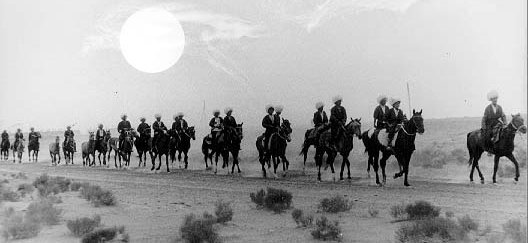|
This unique breed is not less than three thousand
years old. The Akhal-Teke is a direct descendant of the horses
of the Massagetae, the Bactrians and the Alans which were famous
in antiquity. In ancient Persia these horses were known as
Nisaean and several centuries later - as Parthian, but they were
always spoken of as the best in the world. In the second century
B.C. the Roman historian Oppian wrote of them: "These horses,
worthy of the most powerful rulers, are strikingly beautiful in
appearance, they move lightly under the rider and lightly accept
the bit; the head with its Roman nose is carried high and their
golden manes flow majestically in the wind."

After studying most of the relevant historical, archeological
and literary data, modern specialists (V. Firsov, K. Gorelov, V.
Witt, V. Kovalevskaya, E. Ershova, M. Belonogov and others) came
to the conclusion that the Akhal-Teke breed is a strain of the
ancient racehorse that has developed independently. For many
centuries no other breed could compare with it in respect of
size, strength, speed and distinctive beauty.
The antiquity of the breed is beyond dispute, but no specialist,
either now or in the past has been able to explain the
appearance of such a horse on the territory of modern Central
Asia. Its unusual appearance is unlike that of any of the
ancient types of equines. Consequently the theory that this
remarkable breed originated outside the area merits
consideration and in the light of recent archeological findings
in the Altai a number of specialists support this view.
There is clear evidence in modern literature on the subject that
these horses were instrumental in the creation of such world
famous breeds as the Arabian and the English Thoroughbred and in
the improvement of breeds of horses in Russia, Europe and the
Near and Middle East. In the words of Professor Witt, the Akhal-Teke
horse "possesses the last drop of that valuable blood from which
all the breeds of well-bred horses have been developed."
THE DIVINE ARGAMAK
In the Middle Ages the horses of the Central Asian civilisations
of antiquity passed into the hands of the Turkmens who kept pure
the blood of these priceless animals as their qualities
surpassed those of all other breeds. After the annexation of
Turkmenia to the Russian Empire in l88l the Turkmen horse became
known as the Akhal-Teke combining the name of the Teke Turkmen
tribe and the Akhal oasis in the foothills of the Kopet-Dag
mountains. At that time the horses there were kept singly, as
part of the household, surrounded by love and affection and fed
light but highly nutritious food such as alfalfa, barley and
pellets containing mutton fat. Because the owner depended on his
horse for his wellbeing and his very life, no expense was spared
in its care and maintenance. As an old Turkmen saying goes: "The
owner who rears a good horse turns into a lean dog." But the
horse repaid his owner with an exceptional devotion. Mistrustful
of strangers, he gave his heart to his one and only friend.
The Akhal-Teke is indeed endowed with legendary qualities. As a
participant in the battle of Geok-Tepe testified: "An Akhal-Teke
stallion wearing two heavy blankets and wounded by a sabre blow
carried away three Teke tribesmen across the quicksand from
pursuing Cossacks.."
These horses, renowned for their exceptional speed, strength and
beauty, had long since been known as argamaks in Russia where
they were highly valued. To possess an argamak was the dream of
every prince and the argamak was the most sought-after improver
at stud. They were instrumental in the development of the Don
and the Orlov riding horse. In the first half of the eighteenth
century argamaks constituted a third of the stock at state studs.
After the annexation of Turkmenia to Russia many connoisseurs
and horse lovers had the opportunity of familiarising themselves
with the breed and became its passionate admirers. Valuing the
unique qualities of the Teke horse and concerned to preserve the
breed which at that time was in decline for historical and
economic reasons, the governor of the region, General Kuropatkin,
organised at his own expense, the Transcaspian state stables and
invited Russian specialists to work there. This marked the
beginning of the breeding of Thoroughbred stock in the
Transcaspian region and revived interest in the Akhal-Teke
throughout the world. Horses from the Transcaspian stables which
were shown at exhibitions in Kiev, Pyatigorsk and Paris caused a
sensation,and vast sums of money were offered for Teke mares.
Turkmen horses had long since been bred in Russia, but in the
twentieth century they started breeding Akhal-Tekes in the
Northern Caucasus, Stavropol and Kalmykia and today they have
penetrated as far afield as the Leningrad and Kaliningrad
provinces. Russia occupies second place in the world in respect
of the number of Thoroughbred Akhal-Tekes on its territory - and
indeed, "Russians have always loved these horses excessively".
|